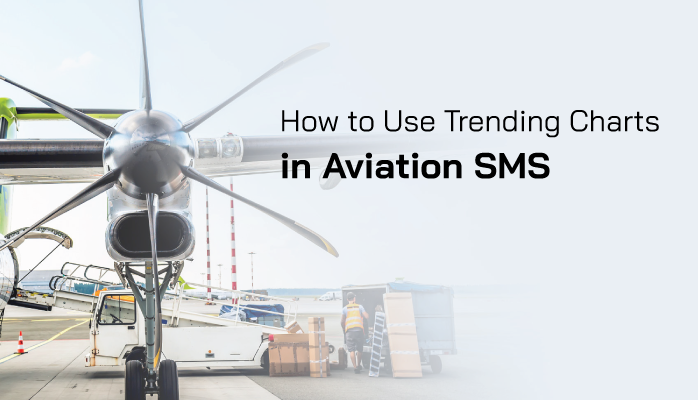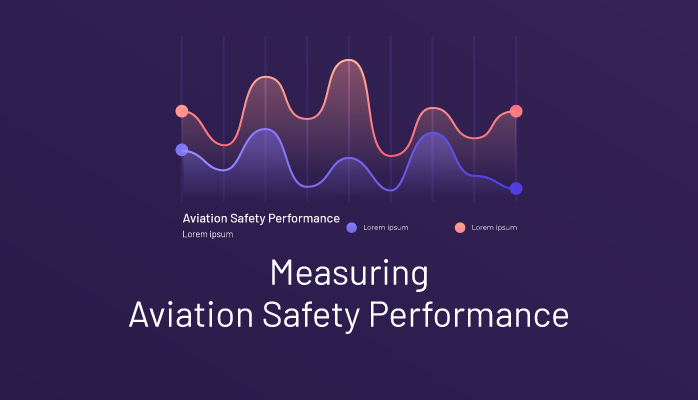Using Trending Charts in Aviation SMS

There are several times each year when managers are interested in trending charts coming from their aviation safety management systems (SMS). These times include during:
- Safety performance monitoring; and
- Determination of continuous improvement progress.
Trending is perhaps among the most difficult tasks for safety managers when they don't have automated tools and databases to capture hazard reports and classify these reported issues.
Let's assume you have data. Which questions should you be asking to generate your trending charts?
What Are Trending Charts
Trending charts are commonly used by managers to understand how an organization is performing in relation to a goal or objective. Trending charts are created using data points over an established time period, such as:
- Month;
- Quarter;
- Semi-annual;
- Year; or
- Five-year period.
Since aviation SMS data must be collected and measured, a database remains the best alternative to store and retrieve data driving the creation of trending charts. Aggregating data manually into MS Excel spreadsheets can be performed by most safety managers, but there is a high degree of risk if your organization is relying upon manual processes.
Manual processes for data collecting and measurements:
- Often include more errors than data pulled from safety databases;
- Require weeks of painstaking labor; and
- Are not repeated regularly as the task is very laborious.
I met a safety manager several years ago who spent three weeks each year aggregating data and generating reports because he relied on paper reports and spreadsheets. After acquiring an aviation SMS database, all managers in his company were able to accurately generate useful trending charts with little effort.
Aviation SMS Databases Require Work in Smaller Increments
Even though an aviation safety database allows managers to generate reports to analyze safety and quality processes, one should not be led to believe that a safety database takes away all work. A spreadsheet is not demanding or sending out notifications that you have work to do. Your SMS database enhances visibility into your risk management processes, while also enforcing accountability. It is hard to hide from regular notifications of overdue tasks.
In the long run, safety and quality managers may be actually spending more time managing SMS data using a safety database than without the database; however, they are doing a little at a time over a prolonged period of time. The results are more accurate and timely when performed properly.
In short, there are two possible processes to collect safety and quality data to generate trending data:
- Incremental gathering and classification of data over time; and
- Aggregating and collating data on an as-needed basis.
For SMS implementations, the first approach is preferable for companies:
- With high employee turnover;
- Having high labor expense (cost per qualified employees);
- Needing immediate, real-time reports to measure performance.
Related Aviation SMS Database Articles
- How to Choose the Best Aviation Safety Database Software
- 7 Signs You Should Invest in an Aviation Safety Management Database
- How Spreadsheet Not EASA Compliant Aviation Hazard Reporting Database
Questions Drive Trending Charts

When you create trending charts, you are basically grouping data according to selected classification parameters over time. Questions drive the generation of trending charts.
- What is management interested in knowing?
- Which elements are important to the company this month/year?
- How are we doing regarding a particular process?
- Are there hidden factors that affect safety performance?
- What happened in the past that we can avoid in the future?
When considering these questions, it may be best to focus on your organization's key performance indicators (KPIs). KPIs have been selected for a particular reason, whether they are important to:
- Upper management;
- Civil aviation authority;
- Safety department; or
- Quality department.
If you have not selected KPIs relating to your aviation SMS implementation, we urge you to do this before you build your classification systems which will drive your trending charts.
Related KPI Articles
- Choosing Key Performance Indicators in Aviation SMS - With Free KPI Resources
- How to Automate Key Performance Indicator KPI Monitoring the Easy Way
- 6 Sources for Aviation Key Performance Indicators
Identify Parameters to Generate Your Trending Chart
When we create trending charts, there are a few variables of interest. They include:
- Which division or part of the company are we interested in monitoring?
- What date range do we want to monitor or review? (start and end dates)
- What types of issues to review?
When we consider "types of issues" to review, we consider:
- Safety;
- Security;
- Quality;
- Compliance;
- Environmental;
- Operational; or
- Human Resources related.
A good trending chart tool will allow you to start with all types of issues and then drill into each specific type on demand. Of course, we are talking about easily and quickly generating real-time reports. The best aviation SMS tools are user-friendly and easy to use by all authorized managers.
Another useful consideration is having the ability to weed out all types of issues except your KPIs. If you are using an aviation SMS database today, you know there are many ways of classifying reported issues or events; however, not all types are important to monitor the process that "answers your questions." Therefore, we need a way to easily filter KPIs from the sea of data.
Generating Trending Charts Should Be Easy and Routine

If you cannot easily and quickly create a trending chart from your data, there is a big risk to your aviation SMS implementation. You cannot effectively monitor safety performance in your SMS implementation without the ability to classify reported issues and easily pull out valuable trending charts.
Trending charts allow management to set goals and objectives and to regularly monitor progress.
Trending charts also increase the effectiveness of safety teams in detecting problem areas that require additional risk management focus. Trending charts look back at historical data. This may cause some safety professionals to question the value of trending charts, but as we have repeatedly heard, "history tends to repeat itself."
From experience, I believe the best example of trending charts' value comes from identifying repeating trends. For example, I recently saw one trending chart that indicated the operator suffered from multiple runway-related issues in 2016. What was interesting to me was that the runway trend declined in 2017, but started to reappear again in late 2018. The trend reappearance was caught early and urged management to review related hazards and risks, and implemented control measures.
This proved to be a great example of where a recurring trend was caught early. Management was able to reduce further losses and adjust operations based on the trend analysis.
Related Trending Chart Articles
- Aviation Safety Managers' Best Friend - Trending Charts
- How to Prepare Data for Trend Analysis in Risk Management Programs
- Six Steps How to Perform Trend Analysis in Aviation SMS
Demonstrate Continuous Improvement Using Trending Charts
You can manually create your trending charts, but if you are like my friend who spent three weeks a year collating data for trending charts, you are probably ready to either:
- Look for a new job; or
- Ignore trending charts next time the request is made.
But the question you must ask management is:
How can our company demonstrate continuous improvement of our SMS to regulatory authorities and SMS auditors without being able to easily create trending charts?
If you need help with trending charts to monitor the progress of your SMS implementation, you should consider SMS Pro. SMS Pro is considered among the best aviation SMS software programs designed specifically for the aviation industry.
If you want to see SMS Pro in action, here are some short demo videos that were recently made.
Last updated in July 2025.






